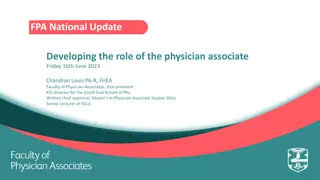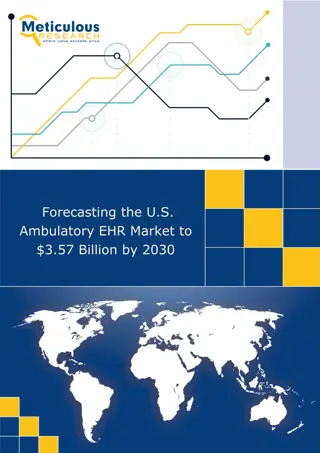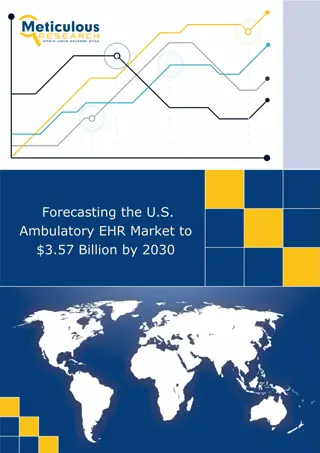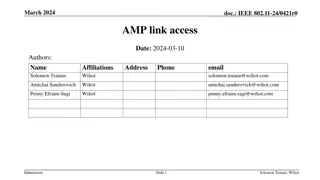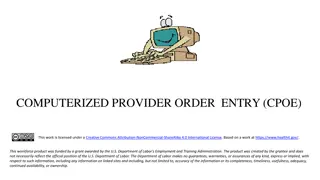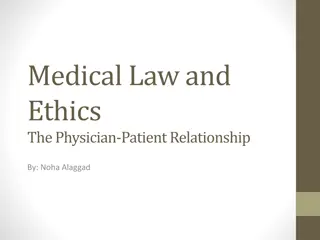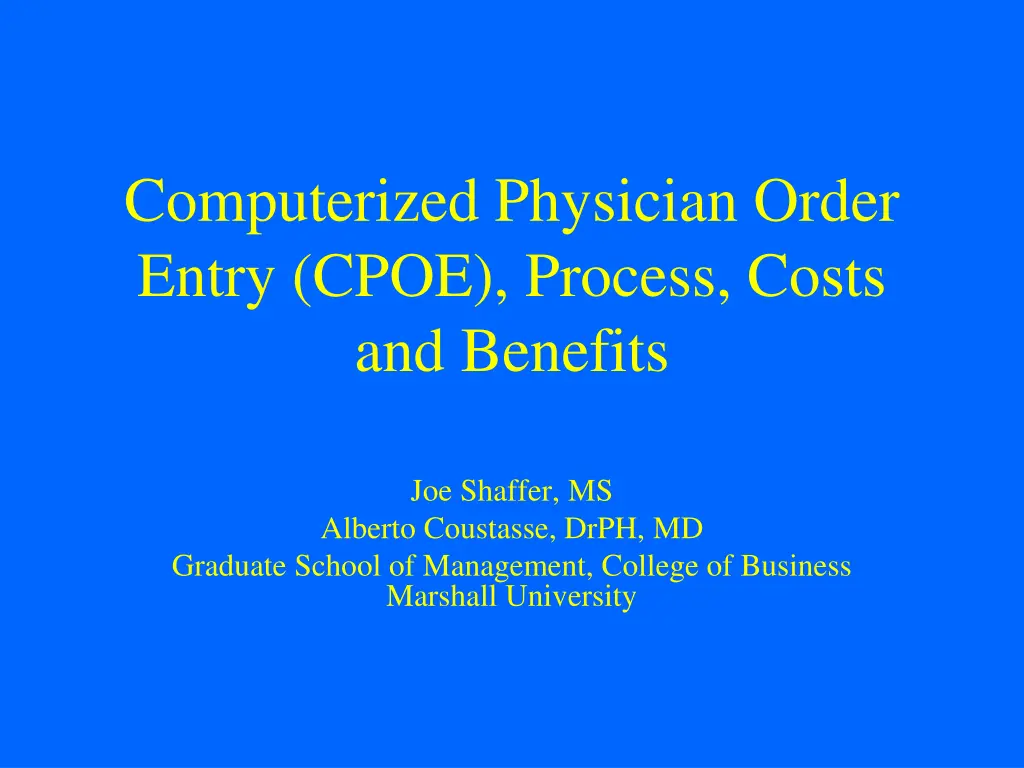
Computerized Physician Order Entry (CPOE): Process, Costs, and Benefits
Explore the significance of Computerized Physician Order Entry (CPOE) in healthcare, its role in reducing medication errors, the impact on efficiency, and the benefits it offers through automation and standardization. Learn about the potential cost savings and improved patient safety associated with CPOE implementation.
Download Presentation

Please find below an Image/Link to download the presentation.
The content on the website is provided AS IS for your information and personal use only. It may not be sold, licensed, or shared on other websites without obtaining consent from the author. If you encounter any issues during the download, it is possible that the publisher has removed the file from their server.
You are allowed to download the files provided on this website for personal or commercial use, subject to the condition that they are used lawfully. All files are the property of their respective owners.
The content on the website is provided AS IS for your information and personal use only. It may not be sold, licensed, or shared on other websites without obtaining consent from the author.
E N D
Presentation Transcript
Computerized Physician Order Entry (CPOE), Process, Costs and Benefits Joe Shaffer, MS Alberto Coustasse, DrPH, MD Graduate School of Management, College of Business Marshall University
INTRODUCTION Computerized Provider Order Entry (CPOE) Medication orders (as well as tests and procedures) are entered into a computer system by a physician or qualified provider. Medication orders are transmitted directly to the pharmacy. At a minimum, ensures standardized, legible, and complete orders. Has the potential to greatly reduce errors at the ordering and transcribing stages.
Adverse Drugs Events (ADEs) & Medication Errors Several studies have found serious medication errors in 3.4%-5.3% of inpatients (8thcause of death, more than HIV+ breast cancer together). 1.5 million medication errors per year. The cost of a single preventable ADE has been estimated to be $4,685. $1.3 million ADE annually for an average 300 bed
INTRODUCTION Health Information Technology for Economic and Clinical Health (HITECH) Act of 2009. Meaningful Use: The use of certified EHR technology for electronic exchange of health information (HIE) to improve quality of healthcare and includes the use of CPOE.
PURPOSE To assess the CPOE to identify areas of benefit and concern.
BENEFITS THROUGH EFFICIENCY Placement of orders to nurse receipt before implementation was 41.2 minutes (38.4 minutes for clerical, 2.1 minutes for finding the chart and .72 minutes for writing the order). After CPOE implementation the order placement was 27 seconds.
MD Unit Sec. Nurse Pharmacy With CPOE Locate Chart Rx Enters the Order If available Notify Nurse Write Order Periodically Review Chart Rack Rx Verifies Order Flag Chart Check Order Completeness Check Order Completeness Return Chart to Rack Notifies Rx Enters Order in Computer Med Sent to Floor Notifies Rx Notify Nurse
BENEFITS THROUGH EFFICIENCY Similarly, the pharmacy had a 64% decrease with 2.24 minutes savings from order entry to pharmacy and 1.36 minutes from pharmacy to medication administration. Clinical Laboratory pathology decreased 25%, from 31:30 to 23:40 minutes.
COST SAVINGS THROUGH EFFICIENCY Nurses workload decreased (4%-6%) due to process medication orders. This was a savings of 20 minutes per nurse per day which was calculated to $715,000 per year. Pharmacists saved 60% of their workload, 200 minutes per pharmacist per day, which was $2,044,000 per year.
ALERT FATIGUE The most recognized overriding complication has been alert fatigue, either the alert was not serious, irrelevant or shown repeatedly. Physicians have been found to lack understanding of workflow interruptions and importance of warnings, and often perceived written orders as superior.
MEDICATION ERRORS Reports have ranged for a 55% to 66% decrease in medication errors in adults. The greatest benefit was demonstrated in one RCT with a decrease of 175 medication errors per 1,000 orders. Also was estimated a prevention of 3 million Adverse Drug Events each year (9 per 1,000 prescriptions in pediatrics and 12 per 1,000 prescriptions in adults).
OVERALL COST In 2003, the overall cost of implementation for the average hospital was $3.2 million. This cost also depends on the hospital bed size: than 200 bed is about $1.4 million. 500 bed plus: $12.5 million. Expenses included professional services (31%), core system (25%), hardware (21%), software (14%) and additional functions (9%).
EVOLUTION Only 10%-15 % of medical facilities have CPOE completely available. Physician Acceptance and Behavioral Changes Training sessions, multidisciplinary teams, and consultation support.
UNINTENDED ADVERSE CONSEQUENCES (UACS) There are nine major categories in order of decreasing frequency: More/new work for clinicians Workflow Never-ending system demands Persistence Changes in communication patterns Emotions New kinds of errors Changes in power structure Overdependence on technology One study was conducted to indentify the different types of UACs resulting from CPOE implementation 79 unintended consequences were identified 245 additional ones were added from fieldwork
DISCUSSION Millions of dollars have been invested in HIT, but still is in infant stage Hospitals need NOT to develop their own software rather joint national standards. Balance on Alerts (otherwise physicians will ignore them).
DISCUSSION There is no measurable ROI for a healthcare setting, however: The virtual ROI s are: CPOE will probably be mandatory If the health care system doesn t have it, there will be financial penalties (meaningful use, 2015) Improved patient safety will result in: Reduction in Medical Errors. Shorter Lengths of Stay. Fewer Law Suits. Better Quality of Care (Better PS & Reputations).
DISCUSSION Most studies have been conducted in large academic centers so further research is required in rural settings.
Questions? coustassehen@marshall.edu




